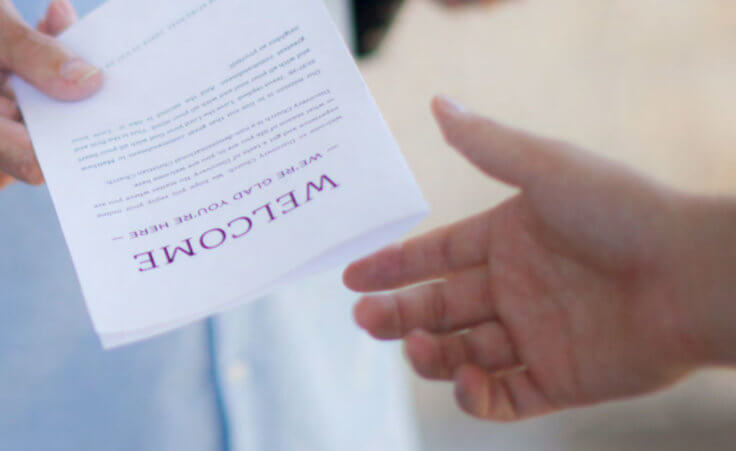
FILE - Palestinian supporters chant as they march during a protest at Columbia University, Thursday, Oct. 12, 2023, in New York. (AP Photo/Yuki Iwamura, File)
One of the shocking consequences of Hamas’s October 7 invasion of Israel has been the rise of antisemitism in the weeks following. According to a recent report from the Anti-Defamation League, for example, antisemitic incidents in the United States rose about 400 percent in the two weeks after Hamas’s atrocities. Nowhere has opposition to Israel been more evident than on America’s college campuses. Hundreds of protests against Israel’s response to the October 7 invasion have been staged by students across the country. The issue is escalating: Cornell canceled classes recently after death threats were posted toward Jewish students, for example.
What is behind these campus movements? How can we respond in ways that are both truthful and redemptive?
I have led more than thirty study tours to Israel across nearly thirty years. In addition, I have taught world religions with four seminaries and have published several books and many articles on Israel and the Middle East. In this paper, I will attempt to distill a great deal of information in a format that answers our most pressing questions about the war between Israel and Hamas, focusing especially on America’s campuses and the rise of college antisemitism in our day.
NOTE: This resource article belongs to a series regarding the foundational issues behind the ongoing war between Israel and Hamas. The full series is also available as a free ebook.
A very short history of the region
According to the Bible, the land now known alternately as “Israel” and “Palestine” was occupied by Canaanite tribes before it was promised to Abraham and his descendants (Genesis 12:1–8) and subsequently conquered by the Jews under Joshua’s leadership (Joshua 1–14). It was ruled by various “judges” (military/political leaders) until the reigns of Saul, David, and Solomon (ca. 1000 BC). Despite civil wars and deportations by foreign empires, Jewish presence remained strong in the land into the Roman era.
The Jews revolted against their Roman oppressors (AD 66–72), leading to the destruction of their temple in AD 70. After a second uprising (the Bar Kochba Revolt of AD 132–35), many Jews were sold into slavery and transported to Egypt. Jewish settlements were not rebuilt, and Jerusalem was turned into a pagan city. The Romans renamed the area Palestina Syria; “Palestina” is a Latin version of “Philistines,” the sea peoples who populated the Mediterranean coast. From that point to the reestablishment of the State of Israel in 1948, the area was commonly known as “Palestine.”
However, it is important to note that “Palestine” was never an autonomous nation. The region was under Roman rule, then Byzantine (Roman and Christian, AD 324–640) before Arab Muslims conquered it in AD 640. The Crusaders defeated the Muslims and held the land from AD 1099 to 1291, when they were defeated by Egyptian Muslim armies, who in turn were subjugated by the Ottoman Empire (AD 1516–1917).
After the Ottoman Empire lost World War I, the area was placed under British control (the so-called British Mandate period). On May 14, 1948, Jewish leaders declared into existence the State of Israel.
Did the Jews steal the land from the Palestinians?
This history leads us to the first reason for opposition to Israel on many college campuses: the claim that the Jewish state is an “occupier” and “colonizer” of land it stole in 1948 from its rightful Palestinian owners.
Russia’s ambassador to the United Nations recently claimed that Israel is an “occupying power” and thus does not have the right to self-defense. The International Court of Justice issued an opinion in 2004 that Israel is in fact an “occupier” of Palestinian lands in Gaza and the West Bank. We are hearing this claim daily now in the news and at pro-Palestinian rallies.
The history of the land is far more complex, however.
Jews in the land
Even after the Romans renamed the region “Palestine” in the second century and deported many of the Jews, there remained a strong Jewish presence in the land, so much so that they staged yet another revolt against a corrupt Roman governor in AD 351–2. A short-lived attempt to rebuild the temple in Jerusalem was made under Emperor Julian (AD 361–3), but an earthquake and Julian’s death ended the effort.
After Arab Muslim invaders conquered the land in AD 640, both Arab and Jewish communities multiplied in Palestine. However, by the end of the eleventh century, the Jewish population had declined significantly, though large Jewish communities remained in Hebron, along the coast, and in areas of Galilee. Tragically, the Crusaders (AD 1099–1291) massacred many of the Jews in Palestine and restricted them from land ownership, though they maintained a large presence in the land, especially in Galilee.
Under the Mamluks, the Jewish presence shrank to an estimated five thousand people. However, under the Ottomans, Palestine saw a resurgence of Jewish life and a repopulation of the land. Throughout the nineteenth century, Jews from Eastern Europe and from Turkey, Bulgaria, and North Africa began immigrating in great numbers to the region. Large waves of settlers followed in the late nineteenth and early twentieth centuries.
By 1947, there were approximately 630,000 Jews living alongside 1.2 million Arabs in Palestine. That year, the United Nations adopted a Partition Plan whereby the West Bank (the area along the west bank of the Jordan River and the Dead Sea, slightly smaller than the state of Delaware) and the Gaza Strip (on the southwest Mediterranean coast, 25 miles long and 4 to 7.5 miles wide) would become the autonomous nation of Palestine for the first time in history. The remaining section in the middle would become the State of Israel.
Jewish leaders accepted this plan, but Arab leaders rejected it. When Israel was declared a nation in 1948, armies from Egypt, Lebanon, Syria, Jordan, and Iraq marched into the territory, launching Israel’s 1948 War for Independence.
Arabs in the land
When the war began, Arabs living in Palestine were encouraged by their leaders to flee to the West Bank and Gaza for what they were assured would be a brief conflict after which they would be permitted to return to their homes. More than seven hundred thousand did so; a third went to the West Bank, a third to the Gaza Strip, and the rest to Syria, Jordan, Lebanon, and other countries, while around 156,000 chose to remain.
Israel won the war, controlling land it would have received under the Partition Plan, while the West Bank remained under Jordanian control and the Gaza Strip was controlled by Egypt. Jewish migration into the new nation grew significantly. Today, the State of Israel numbers nine million, seven million of whom are Jews; the other two million are Arabs, descending primarily from those who stayed in the land in 1948. Another three million Arabs live in the West Bank, and two million in the Gaza Strip.
In the 1967 war, Israel gained control of the West Bank and Gaza Strip. This brought about a second exodus of Palestinians, estimated at half a million. In 1993, the Palestine Liberation Organization (PLO) accepted Israel’s right to exist; in return, Israel supported the creation of a Palestinian Authority (PA) to assume governing responsibilities in the West Bank and Gaza Strip over a five-year period.
In 2005, Mahmoud Abbas, the leader of Fatah (the majority party within the PLO), was elected president of the PA. That same year, Israel withdrew its armies and settlers from Gaza.
The next year, a rival party named Hamas (to be discussed below) won legislative elections but refused to recognize Israel’s right to exist. In 2007, Hamas gained control of Gaza, while Fatah retained control of the West Bank. From then to today, the two rival parties have each claimed to lead the Palestinian people and cause.
Complicating matters further, numerous Jewish settlements have been built in parts of the West Bank, though they do not represent the State of Israel.
Four important facts
So, did Israel steal its land from its rightful Palestinian owners?
Four facts are important:
- The original “owners” of the land were the Canaanites from whom the Jews conquered the land under Joshua. Their descendants now live in Lebanon and bear no genealogical relationship to the Palestinians.
- Present-day Palestinians are descendants of the Arabs who first conquered the land in AD 640, not the Philistines for whom the region is named. They took the land from the Jews and Christians who lived there prior to their conquest.
- The Jews never left the land completely and repopulated it alongside the Arab Palestinians across recent centuries.
- An autonomous nation called Palestine would have been created in 1947, but Arab leaders rejected the United Nations Partition Plan.
Thus, Israel did not steal the land from its rightful Palestinian owners. If anything, the Palestinians’ ancestors stole it from the Jews who were there prior to AD 640.
Israel maintains no presence in Gaza, so it cannot be “colonizing” the region. It granted the PA limited autonomy of the West Bank in 1993, though some Jewish settlements greatly complicate the Palestinian quest for ownership of this area.
In short, while Israel continues to be accused on college campuses and elsewhere of being an “occupying colonizer,” this is not true.
Is Israel oppressing the Palestinians?
The other major accusation made against Israel on college campuses is that the Jews are oppressing the Palestinian people. This charge is fueled by two disparate factors.
Critical theory
The first is known as “critical theory” (CT), a Marxist construct that interprets life within sociological and economic realities. It claims that majorities achieve their status by oppressing minorities. The wealthy gain their wealth by oppressing the poor.
This approach, when applied to race relations, is known as Critical Race Theory (CRT). CRT became much more widely known after the murder of George Floyd in 2020 and resulting “Black Lives Matter” marches. Ibram X. Kendi and others have popularized the “anti-racist” ideology that claims we are either racists or “anti-racists” who actively work to defeat racism. If we are not the latter, we must be the former.
CT is applied to the Middle East with the assertion that the majority Jews are oppressors of the minority Palestinians. CT advocates point to Jewish financial status in the region and claim that such progress has been made by victimizing Palestinians.
This sociological claim has been amplified enormously by Israel’s military response to Hamas’s October 7 invasion and deserves further exploration in that context.
Hamas and the Palestinians
As noted, the political party known as Hamas gained control of Gaza in 2007. It was founded in 1987 and published its official charter in 1988, calling for the destruction of Israel and raising “the banner of Allah over every inch of Palestine.” Its founder, Sheikh Ahmed Yassin, stated that “reconciliation with the Jews is a crime” and claimed that Israel “ must disappear from the map.”
Hamas believes that the Qur’an requires Muslims to defend Islam by attacking Israel and anyone who supports the Jewish people (cf. Qur’an 2:190; 9:5). It views the Jewish people as “apes and swine” (Qur’an 5:60; see 2:65; 7:166). Since Israel is a democracy, Hamas considers its citizens to be complicit in an “attack” on Islam.
As a result, Hamas did not see the October 7 invasion as an assault on innocent civilians. It believes it is defending the Palestinian people and the Muslim world from their oppressors. Many of the pro-Palestinian protesters across US college campuses agree.
However, it is actually Hamas who is the enemy of the Palestinian people.
The terrorists hide their munitions and fighters in a vast network of tunnels beneath homes, schools, mosques, and hospitals used by Palestinian civilians. This way, for Israel to destroy these tunnels, it must destroy civilian structures under which they are located. Hamas has turned hospitals into command and control centers for its militants and hides its soldiers among the civilian population.
In these and other ways, it continues to violate the rules of war as prescribed by the Geneva Convention and other humanitarian laws.
While more than half of the civilians in Gaza are impoverished, several of Hamas’s leaders live in Qatar, more than a thousand miles from Gaza; some are estimated to be billionaires. After their 2014 conflict with Hamas, Israeli officials estimated that the average tunnel built by Hamas required enough construction supplies to build eighty-six homes, seven mosques, six schools, or nineteen medical clinics. Hamas continues to steal fuel, medical supplies, and provisions intended for the civilian population.
The son of a founding Hamas leader states, “I was born at the heart of Hamas leadership . . . and I know them very well. They don’t care for the Palestinian people. They do not regard the human life.” He adds: “Hamas does not serve the Palestinian people. Hamas serves Iran. . . . They are using Palestinian people as a human shield.”
As a result, the Wall Street Journal editorial board recently stated: “Palestinian lives matter, except to Hamas.” Referencing Israel’s challenge in destroying Hamas while protecting civilians in Gaza, the article notes:
Blaming Israel for these civilian casualties amounts to denying the Jewish state its right to self-defense. It means that Hamas can launch attacks on Israel with the goal of slaughtering women and children, but Israel can’t attack Hamas in Gaza because civilians might be unintentional casualties. It means Hamas would retain a terrorist sanctuary from which it can attack Israel whenever it has the means and opportunity.
No other country on earth would agree to the terms of defensive engagement that much of the world wants to impose on Israel.
The dilemma Israel faces
Hamas attacked Israel in 2008, 2012, 2014, and 2021. In addition, it has continually fired rockets into Israel across the last eighteen years. In previous conflicts, the Israel Defense Forces (IDF) have acted to reduce Hamas’s weaponry and ability to wage war, then the two sides have declared cease-fires that left Hamas in control of Gaza.
This time is different.
The October 7 atrocities showed Israeli civilians that Hamas is committed to horrific acts of terrorism against them. More than 245,000 have been forced to evacuate their homes in southern Israel and have not been able to return. Hamas now possesses deadlier weaponry than in previous conflicts.
Accordingly, Hamas is able to threaten the average Israeli citizen in ways the nation has not faced in its seventy-five-year history. Its previous wars have been fought by its soldiers against the soldiers of their enemies. Civilians have not been at risk as they are now.
This is important because so many Israelis live in Israel by choice. Theirs is one of the best-educated, most skilled workforces in the world. Every Israeli I have met would be imminently employable in any nation in the Western world. They choose to live in the State of Israel for the purpose of securing a future for the Jewish people.
If the nation can no longer defend them, its very reason for existence comes into question. And the willingness of its citizens to risk their lives and their families could come into question as well, perhaps leading to an exodus of Israelis out of the nation.
This is why the IDF must defeat Hamas to a degree that its people feel safe in their land again.
Dennis B. Ross, who served in the State Department under President George H. W. Bush and was special Middle East coordinator under President Bill Clinton, recently published an article in the New York Times in which he states: “It is clear to me that peace is not going to be possible now or in the future as long as Hamas remains intact and in control of Gaza. Hamas’s power and ability to threaten Israel—and subject Gazan civilians to ever more rounds of violence—must end.”
He quotes an Israeli commander who said after October 7, “If we do not defeat Hamas, we cannot survive here.”
However, Hamas wants Israel to harm Gazan civilians. It wants to inflame the larger Muslim world, perhaps sparking an intifada (“uprising”) in the West Bank and drawing Hezbollah in Lebanon into the conflict. It wants to use civilian casualties to turn world opinion against Israel, perhaps lessening its military support from the US and other Western nations.
To conclude: Israel’s incursion into Gaza is not an oppression of the Palestinian people—it is a military response to the atrocities of October 7 necessary to preserve the Jewish state and its future. When civilians are harmed as a result, this is the fault of Hamas. The terrorists started this conflict, and they hide behind Palestinians while using them as human shields.
Conclusion: Our third step into spiritual awakening
We have seen that we advance God’s kingdom through spiritual awakening when we make Christ our king and share his word with the world. Now we can add a third step: love all people as Jesus loves all people.
God loves the “world” (John 3:16). In his mind, “there is neither Jew nor Greek, there is neither slave nor free, there is no male and female” (Galatians 3:28). He “shows no partiality” (Acts 10:34); heaven will be filled with people “from every nation, from all tribes and peoples and languages” (Revelation 7:9).
As St. Augustine noted, “God loves each of us as if there were only one of us.”
Accordingly, to “pray for the peace of Jerusalem” (Psalm 122:6) is to pray for God’s best for Israelis and Palestinians, Jews and Muslims. It is to ask for that peace which is not just the absence of conflict but the presence of righteousness. And it is to follow the advice of Israel’s most beloved king thirty centuries ago: “Turn away from evil and do good; seek peace and pursue it” (Psalm 34:14).
As with ancient Israel, so with God’s people today—we are to be not containers but conduits of his blessings for the world. This means that we manifest “kindness” as a “fruit of the Spirit” (Galatians 5:22) and choose “compassionate hearts, kindness, humility, meekness, and patience” (Colossians 3:12). We are to follow the example of the One who “came not to be served but to serve, and to give his life as a ransom for many” (Mark 10:45).
Such compassion is God’s requirement for his people:
He has told you, O man, what is good;
and what does the Lᴏʀᴅ require of you
but to do justice, and to love kindness,
and to walk humbly with your God? (Micah 6:8).
Such love expresses God’s heart for Jews and Palestinians. It grieves with every Israeli civilian who was victimized by Hamas’s atrocities and with every Palestinian civilian suffering now in Gaza. It seeks practical ways to demonstrate such compassion: “If anyone has the world’s goods and sees his brother in need, yet closes his heart against him, how does God’s love abide in him?” (1 John 3:17).
Through such compassionate kindness, we become the change we wish to see and God does through us what he does in us.
Many years ago, I heard a missionary pray, “Lord, break my heart for what breaks your heart.”
Will you make his prayer yours today?














